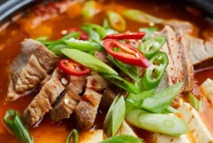Brigadeiro is a traditional Brazilian sweet, often described as a chocolate truffle. It is one of the most iconic and beloved desserts in Brazil, commonly enjoyed at birthday parties, festivals, and celebrations. The treat is made with condensed milk, cocoa powder, butter, and chocolate sprinkles. Brigadeiro is named after a Brazilian military figure, Brigadeiro Eduardo...
Learn moreBolinhos de Bacalhau (translated as “Codfish Cakes”) are a popular Brazilian snack or appetizer made from salted codfish (bacalhau), potatoes, onions, parsley, and egg, all formed into small fritters and deep-fried until golden and crispy. This dish is often served in bars, restaurants, and during festive occasions like Christmas, Carnival, and family gatherings. Bolinhos de...
Learn moreAcarajé is a traditional Brazilian dish from the Northeast region, particularly associated with Bahia. It is a popular street food made from black-eyed peas, which are pounded into a paste, formed into small fritters, and then deep-fried in palm oil. The dish is typically served with a variety of fillings such as shrimp, vatapá (a...
Learn moreTteokbokki (떡볶이) is a popular South Korean street food made with chewy rice cakes (tteok) cooked in a spicy, sweet, and savory gochujang-based sauce. It is a beloved comfort food in Korea, often enjoyed as a snack or light meal. Key Ingredients: Tteok (Rice Cakes): Cylindrical-shaped, chewy rice cakes. Gochujang (Chili Paste): A fermented red...
Learn moreSamgyetang (삼계탕) is a traditional South Korean ginseng chicken soup. It is a hearty and nutritious dish made with a whole young chicken stuffed with glutinous rice, ginseng, garlic, jujubes (Korean dates), and sometimes ginger. The soup is known for its rich, aromatic broth and is often consumed to boost energy and immunity, especially during...
Learn moreSamgyeopsal (삼겹살) is one of South Korea’s most popular dishes, consisting of thick, fatty slices of pork belly that are grilled at the table. The name “Samgyeopsal” translates to “three-layered flesh”, referring to the three layers of meat and fat visible in the pork belly cuts. It is often enjoyed in a social setting, making...
Learn moreNaengmyeon (냉면) is a popular South Korean cold noodle dish, especially enjoyed during the hot summer months for its refreshing and cooling qualities. The name “Naengmyeon” translates to “cold noodles”, and it is typically served in a chilled broth or as spicy mixed noodles without broth. This dish originated in North Korea but became widely...
Learn moreKimchi Jjigae (김치찌개) is a traditional South Korean stew made primarily with fermented kimchi and often cooked with pork, tofu, and vegetables. It is one of Korea’s most beloved comfort foods, known for its rich, spicy, and tangy flavors. This dish is frequently served as a hearty meal or a side dish alongside rice. Key...
Learn moreKimchi (김치) is a traditional South Korean fermented vegetable dish, most commonly made with napa cabbage or radish and seasoned with a variety of spices and aromatics. It is a staple side dish (banchan) in Korean cuisine and is enjoyed for its spicy, tangy, and umami-rich flavor. Key Ingredients: Vegetables: Napa cabbage (Baechu) or Korean...
Learn moreKimbap (김밥), often referred to as Korean sushi, is a popular and versatile Korean dish made by rolling rice and various fillings in seaweed (gim). It is commonly served as a snack, picnic food, or lunch box item and is a staple in Korean cuisine due to its portability and delicious combination of flavors. Key...
Learn more










Login with